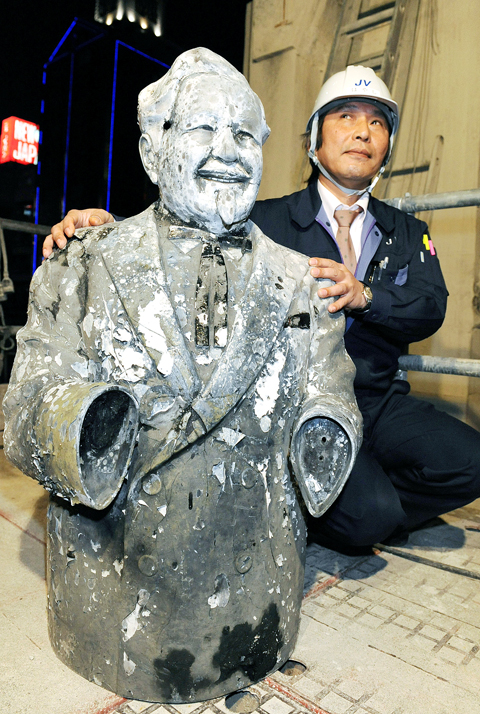He was covered in mud when pulled from the river and had lost both legs and hands, not to mention his glasses. But Colonel Sanders still had his trademark smile, 24 years later.
A statue of the KFC mascot has been found in a river in Osaka, a city official said yesterday, nearly a quarter century after being tossed in by crazed baseball fans who felt the image of restaurant founder Harland Sanders resembled a key team member.
“He was apparently found standing upright, which is fitting, because although he was a nice man he could also be very strict and demanding,” said Sumeo Yokakawa, a spokeswoman at the chain’s Tokyo headquarters.

PHOTO: AP
She said the statue was taken from a nearby KFC restaurant and tossed in the river as part of a celebration by baseball fans in 1985, the year Osaka’s baseball team, the Hanshin Tigers, won the national championship.
Local fans thought the Colonel bore a resemblance to Randy Bass, a bearded power hitter and first baseman from the US who played for the team at the time.
Fans often jump into the murky river to celebrate the team’s successes, but there has been little to celebrate in recent years.
Many fans feel the team has been plagued by the “curse of Colonel Sanders” since his effigy was submerged in 1985.
It has failed to win a national championship since, although it did win its division in 2003.
The upper half of the statue was found on Tuesday in Osaka’s Dotonburi River during construction work to build a new walkway, city official Hideo Yuko said. His legs and right hand were found yesterday morning.
The colonel will be kept in police custody for the time being, but Yokakawa said KFC was considering donating him to the home stadium of the Tigers in Osaka. The store where he originally stood has since closed.
The KFC chain operates about 1,160 restaurants in Japan and has about 1,000 Colonel Sanders statues in the country.
Osaka, Japan’s second-largest city after Tokyo, is located about 420km west of the capital.

Former Nicaraguan president Violeta Chamorro, who brought peace to Nicaragua after years of war and was the first woman elected president in the Americas, died on Saturday at the age of 95, her family said. Chamorro, who ruled the poor Central American country from 1990 to 1997, “died in peace, surrounded by the affection and love of her children,” said a statement issued by her four children. As president, Chamorro ended a civil war that had raged for much of the 1980s as US-backed rebels known as the “Contras” fought the leftist Sandinista government. That conflict made Nicaragua one of

COMPETITION: The US and Russia make up about 90 percent of the world stockpile and are adding new versions, while China’s nuclear force is steadily rising, SIPRI said Most of the world’s nuclear-armed states continued to modernize their arsenals last year, setting the stage for a new nuclear arms race, the Stockholm International Peace Research Institute (SIPRI) said yesterday. Nuclear powers including the US and Russia — which account for about 90 percent of the world’s stockpile — had spent time last year “upgrading existing weapons and adding newer versions,” researchers said. Since the end of the Cold War, old warheads have generally been dismantled quicker than new ones have been deployed, resulting in a decrease in the overall number of warheads. However, SIPRI said that the trend was likely

BOMBARDMENT: Moscow sent more than 440 drones and 32 missiles, Volodymyr Zelenskiy said, in ‘one of the most terrifying strikes’ on the capital in recent months A nighttime Russian missile and drone bombardment of Ukraine killed at least 15 people and injured 116 while they slept in their homes, local officials said yesterday, with the main barrage centering on the capital, Kyiv. Kyiv City Military Administration head Tymur Tkachenko said 14 people were killed and 99 were injured as explosions echoed across the city for hours during the night. The bombardment demolished a nine-story residential building, destroying dozens of apartments. Emergency workers were at the scene to rescue people from under the rubble. Russia flung more than 440 drones and 32 missiles at Ukraine, Ukrainian President Volodymyr Zelenskiy

Indian Prime Minister Narendra Modi is to visit Canada next week, his first since relations plummeted after the assassination of a Canadian Sikh separatist in Vancouver, triggering diplomatic expulsions and hitting trade. Analysts hope it is a step toward repairing ties that soured in 2023, after then-Canadian prime minister Justin Trudeau pointed the finger at New Delhi’s involvement in murdering Hardeep Singh Nijjar, claims India furiously denied. An invitation extended by new Canadian Prime Minister Mark Carney to Modi to attend the G7 leaders summit in Canada offers a chance to “reset” relations, former Indian diplomat Harsh Vardhan Shringla said. “This is a